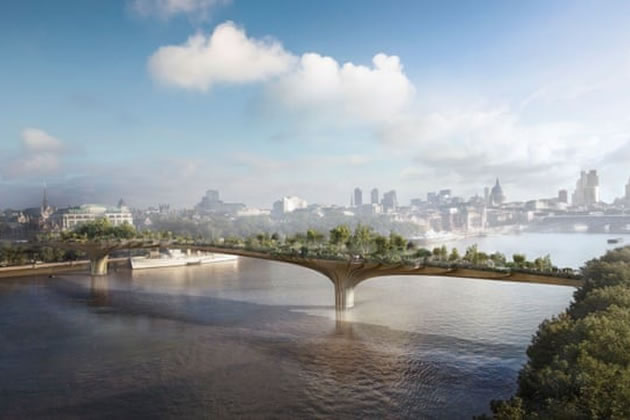Garden Bridge Cost Exceeded Total Spent on Bridges Over a Decade
TfL facing significantly increased maintenance expense over next ten years

The total cost to the taxpayer of the Garden Bridge plan is an estimated £43 million
It has been revealed that TfL’s £24 million spend on the failed Garden Bridge equalled more than half of all the money it spent on the capitals’ bridges over the last decade.
Some £43 million of public money was spent on the Garden Bridge, the pet project of former London Mayor turned Prime Minister Boris Johnson and promoted by Joanna Lumley.
It would have linked the South Bank with Temple Tube Station, and have been lined with dozens of trees. The project was killed off in 2017, before any building work had taken place, when Sadiq Khan withdrew funding.
But £24 million of that funding came from TfL while the rest was spent by the Department for Transport.
By comparison, TfL spent just under £43 million on the upkeep of all of London’s river crossings in the ten years up to 2020/21.
A further £13 million was spent on proposals for a bridge between Rotherhithe and Canary Wharf, before it was axed in 2019.
The last 12 months have seen widely reported criticism of how London’s bridges have required expensive maintenance work, most notably Hammersmith Bridge.
Hammersmith Bridge, which closed to vehicles 23 months ago, currently requires stabilisation works estimated at £40 million before it can carry pedestrians. A full repair job of its cracked pedestals has been quoted at £140 million.
The £43 million spend was revealed in a letter from TfL commissioner Andy Byford to London assembly member Murad Qureshi (Labour).
Contrasting the figures raises questions about Boris Johnson’s support for the Garden Bridge, which would only have allowed pedestrians to cross it, with cyclists needing to dismount.
Glynn Barton, TfL’s director of network management, said, “All bridges maintained by TfL are safe and we continue to invest in them regularly to ensure that they can remain open to all road users. This includes regular structural inspections and carrying out day-to-day and large-scale maintenance whenever necessary to ensure they continue to be in good working order.”
Downing Street has been approached for comment on the PM’s support for the Garden Bridge.
The ill-fated project was effectively scrapped by Sadiq Khan who withdrew funding after he took office as Mayor in 2016. A review showed that its eventual price tag – dependent on private funding – would have been £200 million.
Many of London’s bridges are not owned by TfL, although it heavily subsidises their maintenance.
According to Mr Byford’s letter, between 2010/11 and 2020/21 TfL spent £24 million on five bridges that are owned by local authorities: Chelsea Bridge, Albert Bridge, Wandsworth Bridge and Putney Bridge.
Over those 10 years, TfL spent £3.4 million on bridges owned by the Bridge House Estates: Tower Bridge, London Bridge, Southwark Bridge, the Millennium Bridge and Blackfriars Bridge.
And it spent £15.4 million on the bridges it solely owns: Battersea Bridge, Chiswick Bridge, Kew Bridge, Lambeth Bridge, Twickenham Bridge, Vauxhall Bridge and Westminster Bridge.
Mr Byford’s letter also reveals how it will spend “estimates totalling £135 million-£215 million for the next 10 years”. This includes:
Vauxhall Bridge £40-60m 2023-2025
Lambeth Bridge £20-35m 2023-2028
Kew Bridge £15-30m 2024-2026
Twickenham Bridge £20-30m 2027-2029
Battersea Bridge £15-25m 2027-2030
Westminster Bridge £25-35m 2029-2031
Although its spending was an issue before the pandemic hit, TfL’s finances collapsed into crisis over the last 12 months while its fare revenue dropped by more than 90 per cent.
It received Government bailouts of £1.6 billion in May and £1.8 billion in November. TfL chiefs and civil servants are thrashing out the terms of its next deal, due to be announced by April, the new financial year.
Owen Sheppard - Local Democracy Reporter
March 5, 2021